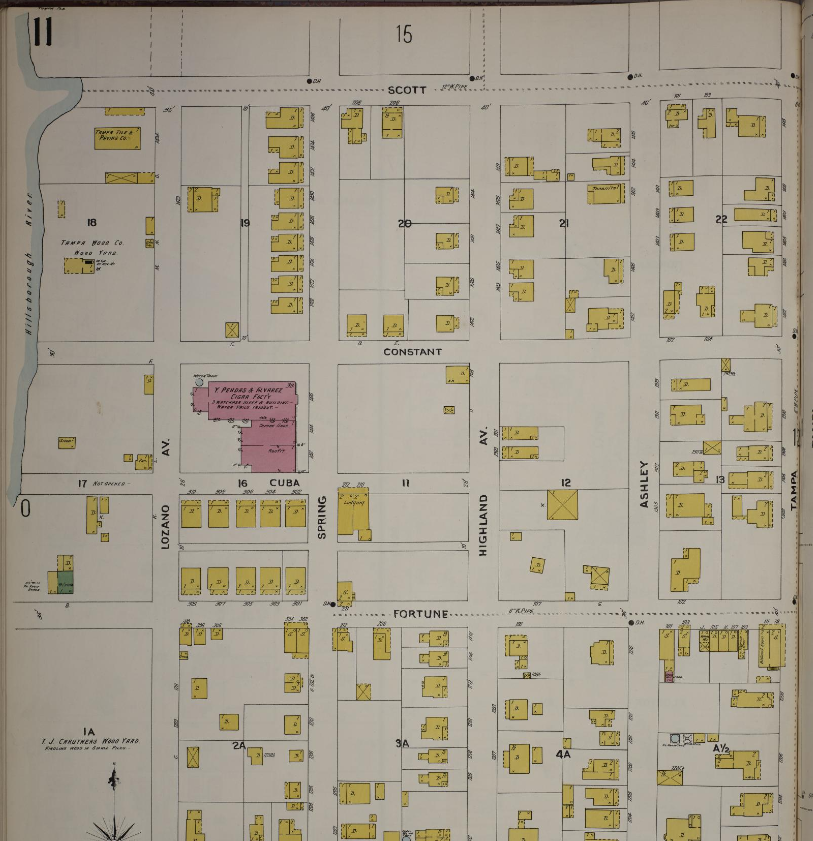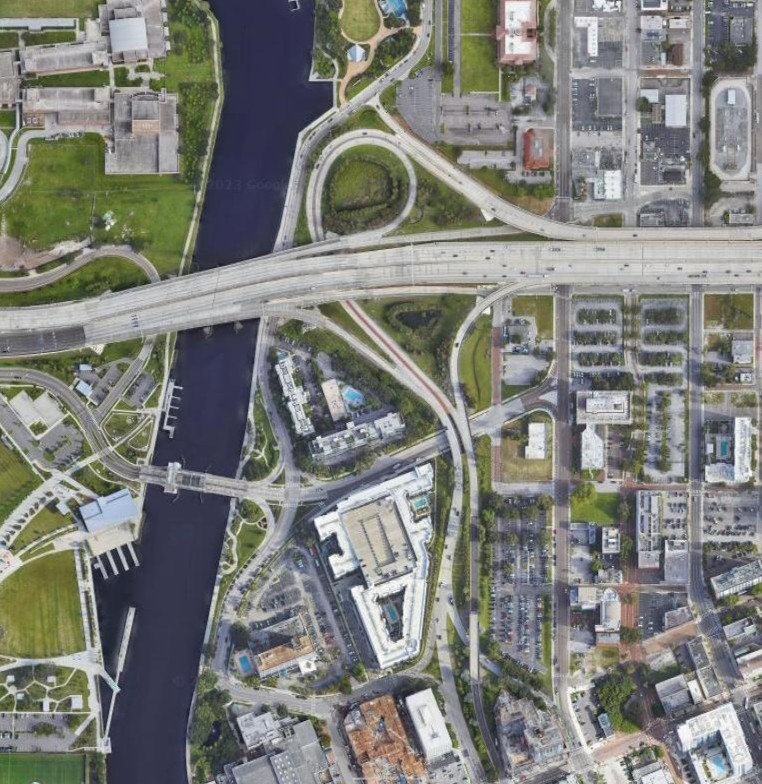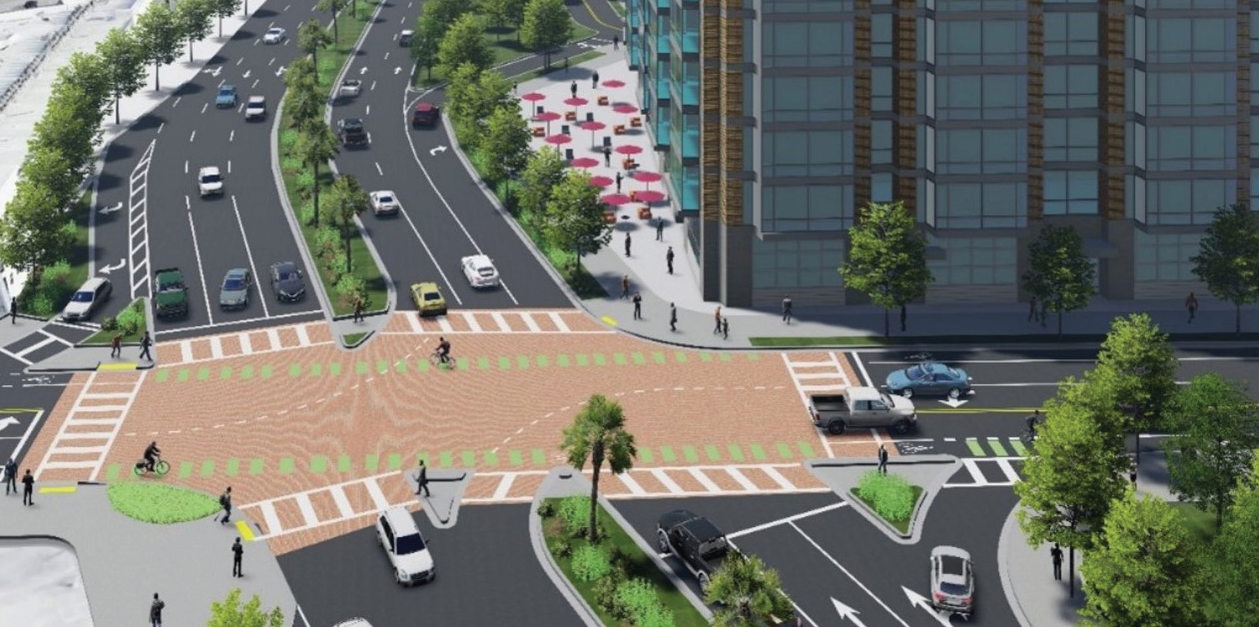June 8, 2023
In February 2023, U.S. Transportation Secretary Pete Buttigieg announced the first round of funding awards for the Reconnecting Communities Pilot Grant Program: $185 million for 45 communities (6 Capital Construction Grants and 39 Planning Grants). The first Federal program of its kind, Reconnecting Communities is dedicated to righting past wrongs and restoring economic vitality to communities that were previously cut off from opportunities by transportation infrastructure.
One of those communities is North Downtown Tampa. In 1962, with the construction of Interstate 275, a portion of Ashley Drive was converted into a grade-separated freeway ramp, creating an impassable barrier that cut off historically Black neighborhoods from the rest of downtown. The ramp also routes high speed regional traffic into Tampa’s urban core, resulting in high-speed traffic along the city’s iconic riverfront.
Uniting Neighborhoods and Infrastructure for Transportation Equity (UNITE): Ashley Drive was one of six projects to receive Capital Construction Grant funding from the Reconnecting Communities Grant Program, and it could not be a better representation of the spirit of the grant. Read on to learn more about this project and how the City of Tampa’s compelling grant application told its story.
The History of Ashley Drive
Prior to the construction of Ashley Drive and I-275, Tampa’s Hillsborough River was lined by predominantly Black neighborhoods, including “The Scrub”-an epicenter of Black business and culture. The construction of I-275 and Ashley Drive cut off The Scrub from the north and west, effectively erasing Tampa’s legacy of Black success. Sadly, this was not just an unintended consequence: zoning plans indicate that planners and city officials intentionally used the construction of the interstate as a tool of segregation. Later, officials used eminent domain to condemn The Scrub and replace the neighborhood with public housing.

North Downtown Tampa used to provide direct access to the riverfront. Credit: Sanborn Fire Insurance Maps.

An aerial view of North Downtown Tampa today. Credit: Google, © 2023 Airbus/CNES, Airbus/Maxar Technologies, U.S. Geological Survey, Map data © 2023.
Over time, Ashley Drive’s geographic and social rift in downtown Tampa festered. The roadway’s placement destroyed businesses on either side and stamped the life out of the working waterfront. Larger developments, office buildings, and sprawling parking lots ate away at local businesses. Fortune Street (named for Madame Fortune Taylor, a formerly enslaved woman who became a successful businesswoman in Tampa) once spanned the entire east-west length of the downtown. Today, it is only a single block long.
In working with the City of Tampa on an application for funding to tear down the ramp spur, we spoke directly with many residents of North Downtown Tampa. One of these residents is Gloria Jean Royster, who walks with a cane and must make a difficult choice whenever she wants to visit Tampa’s Riverwalk. Ms. Royster can either make what locals call the “Ashley Dash”-a series of east-west crossings against high-speed vehicle traffic without traffic signals-or walk an additional four blocks.
Ms. Royster connected us with several other residents with stories to tell. One of them recounted the neighborhood before the construction of I-275 as its own small city: “it had everything, you never needed to leave.” They described the area as a tropical paradise; yards were filled with orange, pineapple, and grapefruit trees along with flowers and water lilies up and down the neighborhood.
UNITE: Ashley Drive
In their grant application for UNITE: Ashley Drive, the City of Tampa shared the direct feedback of these residents and many others in the neighborhoods that have never recovered socially or economically from the loss of The Scrub and the bisection of North Downtown. All but one of the census tracts surrounding Ashley Drive currently qualify as low-income zones. In census tract 51.01, through which Ashley Drive runs, the poverty rate sits at 23%: 10% higher than the statewide average.
UNITE: Ashley Drive is a plan to restore community connectivity by lowering Ashley Drive’s interchange ramp to street level, re-stitching Downtown Tampa’s urban fabric and reconnecting Tampa’s historic street grid. Once completed, this project will:
- Reconnect Tampa’s historic street grid by bringing the freeway ramp down to grade and introducing new roadway connections at Harrison Street and Royal Street
- Provide new, direct bicycle and pedestrian routes to the river and upgrade existing active transportation facilities
- Create new opportunities for affordable housing, park space, and placemaking
- Engage community members through the establishment of a Community Advisory Committee
The City of Tampa has been working toward this project for some time. The need to transform Ashley Drive was first identified in 2011 as part of the City of Tampa’s InVision City Center Plan, which highlighted the corridor as a barrier that prevented access to the riverfront. FDOT studied the traffic trade-offs in 2018 and looked for ways to integrate the project into a planned interstate project. From 2020-2022, the City conducted extensive public engagement which provided them with a strong foundation to submit a grant application in 2022.
This project will be part of a larger multi-agency and public/private partnership that will reconnect and reimagine the greater North Downtown area. The City will use the Reconnecting Communities funds for new roadway connections, the removal of a portion of the Ashley Drive off-ramp and one of the flyovers, the installation of new signals, new and improved active transportation facilities, and traffic calming measures. Construction is expected to begin in the next five years.

The need to transform Ashley Drive was first identified in 2011 as part of the City of Tampa's InVision City Center Plan.

This project will be part of a larger multi-agency and public/private partnership that will reconnect and reimagine the greater North Downtown area.
What Made Tampa’s Reconnecting Communities Grant Application Successful?
It’s hard to argue with how well this project represents the intent of the Reconnecting Communities Grant Program. The City of Tampa’s grant application highlighted the project’s alignment with the program through:
- Connecting with people who have been impacted by the transportation infrastructure in the past and telling their stories. USDOT wants to hear direct feedback from communities they are considering for funding.
- Finding community partners. Ms. Royster, the community advocate we quoted earlier in this article, has spent years documenting the history of the area and connecting with the families we interviewed and has been a tremendous partner in this process.
- Thinking beyond the traditional benefit/cost analysis. For projects like this one that are removing or transforming infrastructure that’s been a barrier to communities, traffic and safety aren’t the only items to quantify (and traditional traffic benefits are not the purpose of these projects). Look for ways to quantify the benefits of more active transportation through health impacts and emissions reduction, redevelopment potential, and other numbers that demonstrate positive outcomes for the community.
- Explaining how the project will right past wrongs. In this case, the City isn’t just removing the ramp spur that split these North Tampa neighborhoods; they are using the land to build affordable housing and infuse the area with economic vitality. This project will support the healing, reconnecting, and reuniting of this fractured community.
The establishment of the Reconnecting Communities grant program is a heartening step for our profession, and it’s meaningful for us to be a part of these projects and help link communities with funding that acknowledges and seeks to mitigate historical inequities. USDOT is preparing to offer the next round of funding for the Reconnecting Communities program in Summer 2023. If you’ve got your eye on a Reconnecting Communities grant, the time is now to start compiling application materials! Read more about the program here and if you’d like to talk further about what this process looked like for Ashley Drive, don’t hesitate to reach out.
